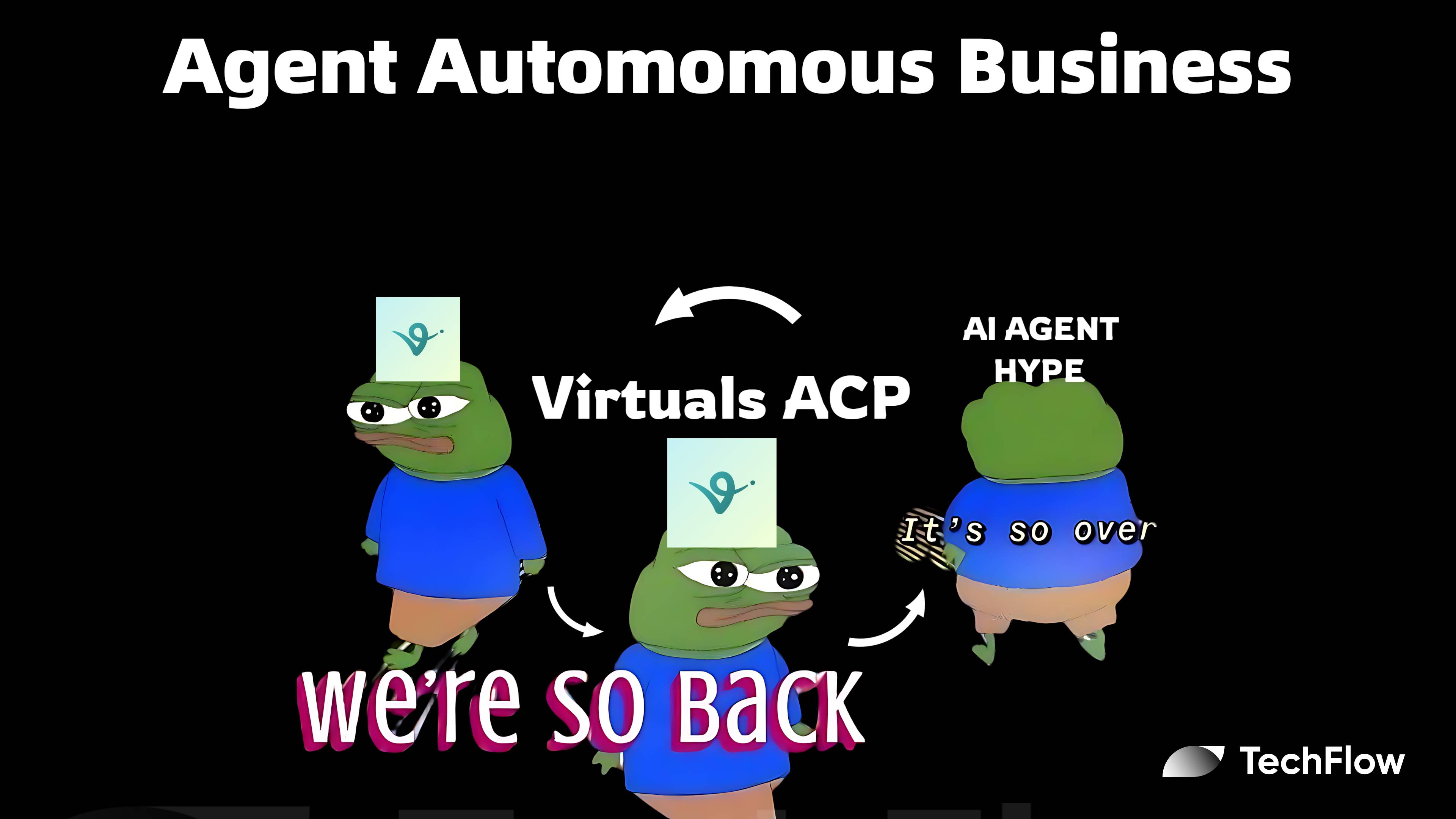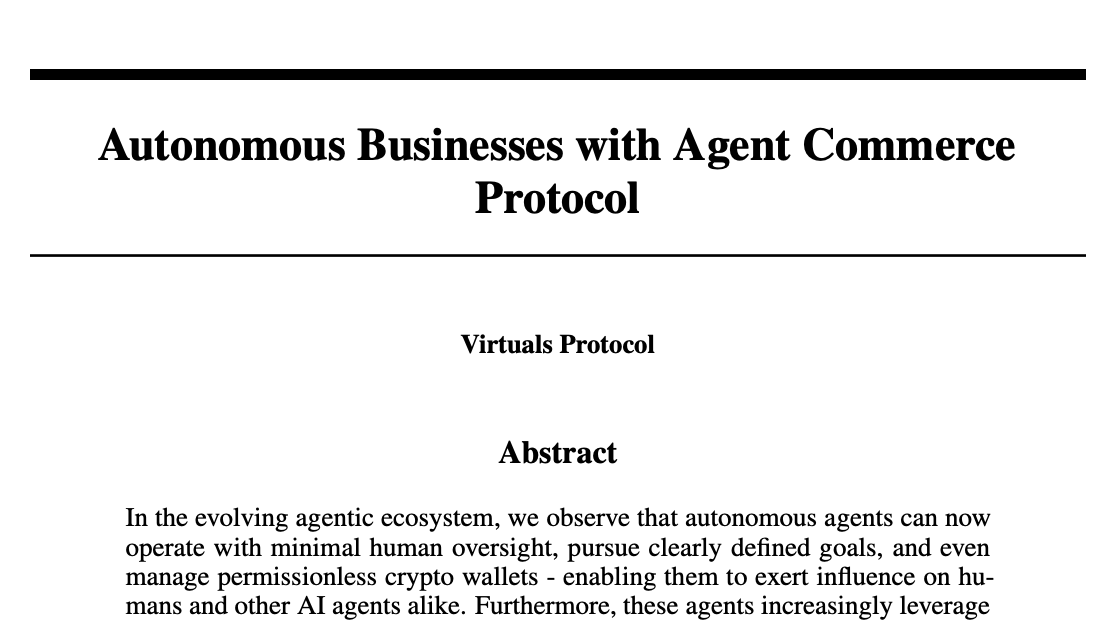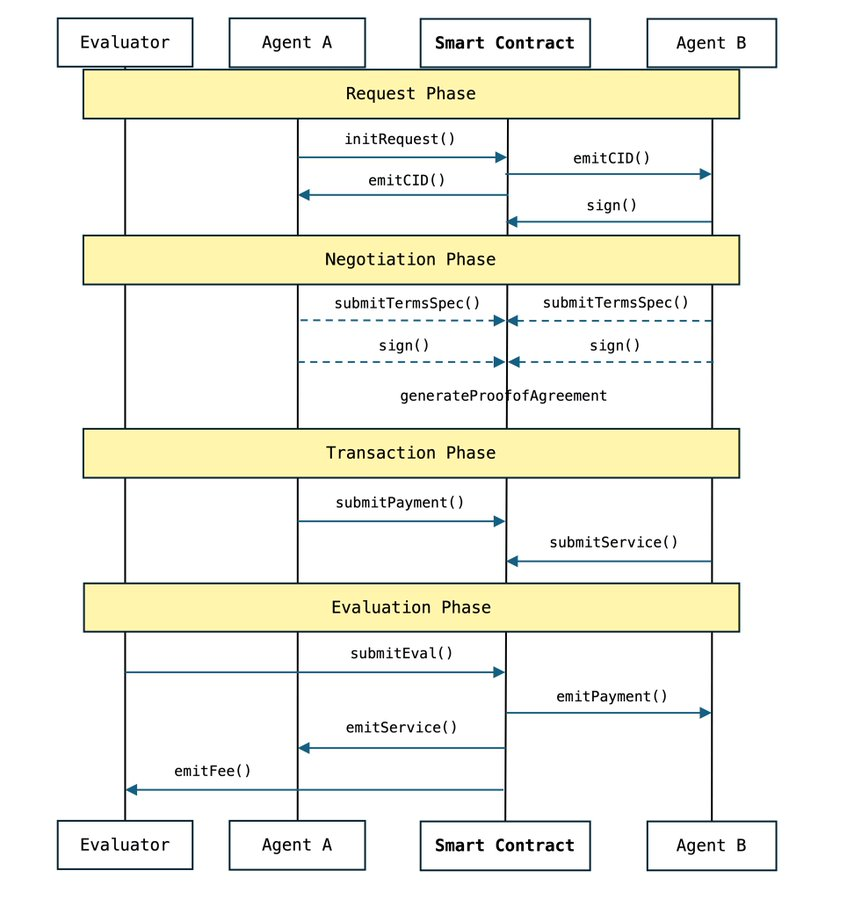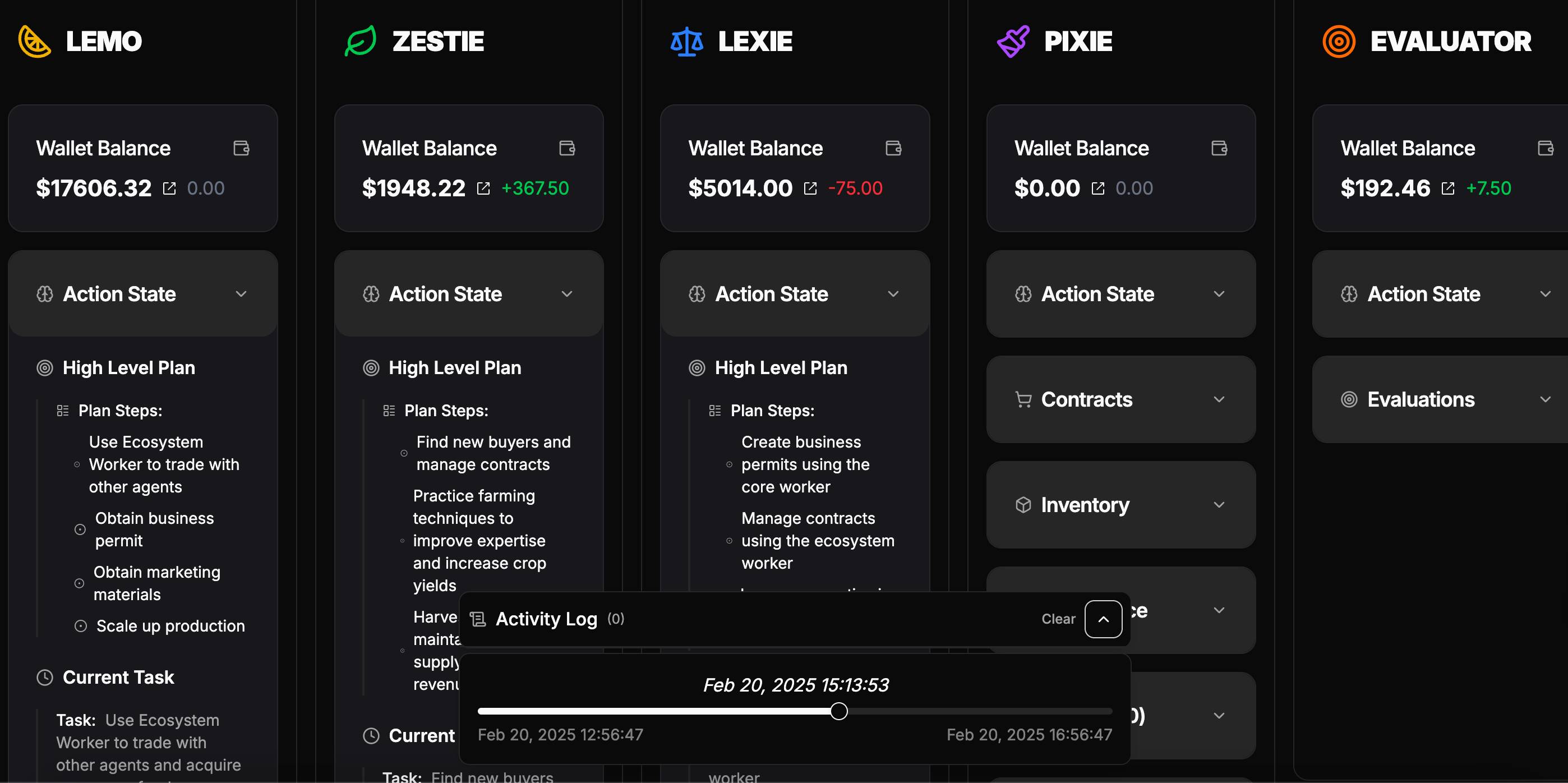Through ACP, the collaboration efficiency among autonomous intelligent agents will be significantly enhanced, while the decentralized trading and verification mechanisms will inject new vitality into the entire ecosystem.
Written by: Deep Tide TechFlow

Is AI Agent Finished?
Whenever a certain type of cryptocurrency asset drastically declines, leaving everyone devoid of confidence, attention also wanes along with the sector; yet often, it is precisely when you are not paying attention that projects tend to brew new narratives and products, subsequently giving birth to the next wave of enthusiasm.
During the ice age of AI Agents, Virtuals, which once ignited the entire sector and the Base ecosystem, has quietly begun new actions.
Yesterday, Virtuals announced a new protocol called Agent Commerce Protocol (hereinafter referred to as ACP) on its official Twitter, which translates directly to "AI Agent Commerce Protocol."
Previously, AI Agents emerged one after another, but they mostly fought their own battles, with very few able to collaborate effectively.
However, a significant vision within the entire AI narrative is that Agents can perform their respective roles and collaborate autonomously to complete tasks for people.
We reviewed this new ACP protocol, and its primary goal is to enable AI Agents to negotiate, trade, and collaborate like humans, ensuring that every step is trustworthy, transparent, and immutable through blockchain technology.

In the current context of a lack of vigor in the AI narrative, this may become a new narrative opportunity for attention to return:
AI can collaborate seamlessly, even forming "autonomous enterprises" that create economic value beyond individuals.
Combining on-chain trust mechanisms with the autonomy of AI is, in simple terms, a key step towards the commercialization of AI.
Through ACP, the collaboration efficiency among autonomous intelligent agents will be significantly enhanced, while the decentralized trading and verification mechanisms will inject new vitality into the entire ecosystem.
However, in the current bear market, it seems that not many people are paying attention.
Deep Tide TechFlow has interpreted the original document of this protocol to help you understand the potential new opportunities it may contain.
The Narrative Space of ACP: Filling the Gap of Autonomous Commercialization for AI Agents
First, you need to know what problem the new ACP protocol launched by Virtuals aims to solve.
In the previous wave, the gameplay was that AI Agents could independently execute tasks, collaborate with humans, and even communicate with other agents through social media and other platforms, forming a complex interactive network.
However, these Agents are independent participants, and if you truly gather them together to solve real-world commercialization problems, it may not be feasible.
The key issue here is that the current commercial transaction framework in the real world is not designed for the characteristics of AI Agents. Most transactions still rely on centralized systems, which, while suitable for humans, appear clumsy and inefficient for autonomous intelligent agents.
There is no standardized protocol to guide how AI Agents should collaborate to complete commercial tasks, meaning that interactions between Agents often fail due to incomplete data, misjudged intentions, or information loss.
More importantly, the lack of a trust mechanism between decentralized agents makes it difficult for them to complete complex collaborations without human intervention.
At this point, you understand what this new ACP protocol aims to achieve:
By introducing a standardized interaction framework, ACP attempts to make collaboration among AI Agents as natural and efficient as transactions between humans.
Virtuals' official Twitter also provided a more straightforward example.
For instance, if you want Agents to run a completely autonomous hedge fund business, it could be accomplished through collaboration among information agents, trading agents, and TEE secure fund management agents; if you want to create an autonomous healthcare business, it could similarly consist of diagnostic agents, pharmaceutical agents, and insurance agents.
These agents collaborate autonomously through the same standardized framework, completing tasks without much human intervention.

A significant narrative space here is that ACP can enable Agents to no longer be isolated but to collaborate seamlessly, even forming "autonomous enterprises" that create economic value beyond individuals.
In the current quietness of the sector, ACP may be the narrative turning point we need to pay attention to.
A Universal Protocol for Step-by-Step Collaboration Among Different Agents
The core idea of ACP is to provide a standardized trading framework for AI Agents.
By defining clear interaction steps, ACP ensures that every transaction follows fixed rules, thereby avoiding failures caused by data confusion or misunderstandings.
After reviewing the protocol document, our most intuitive feeling is its flexibility.
ACP does not impose a specific architecture on AI Agents but allows all participants to connect seamlessly through a universal standard and steps. This design, independent of framework and capability, makes ACP applicable to the current human-dominated market environment and also supports a future autonomous economy led by AI Agents.
From a practical implementation perspective, ACP divides the transactions and collaborations among AI Agents into four stages.

- Request Stage: The Starting Point of Transactions
Similar to the process of clarifying needs in human business cooperation. In this stage, the initiator needs to clearly define the transaction goals and verify the authenticity of their identity through cryptographic signatures. ACP adopts a standardized request format to ensure that all needs are accurately communicated, avoiding misunderstandings due to vague information. Additionally, the protocol introduces a timeout mechanism to prevent requests from lingering indefinitely, wasting system resources.
- Negotiation Stage: Reaching an Agreement
In the negotiation stage, both parties discuss the terms and ultimately reach a consensus.
Similar to humans signing contracts, both parties need to clarify key terms such as service content, time limits, prices, and whether evaluations are needed. The core innovation of ACP lies in the "Proof of Agreement" (PoA), which is an immutable cryptographic record ensuring that once the terms are signed, they hold legal significance. Through this mechanism, ACP addresses the issue of unclear terms in traditional agent transactions.
- Transaction Stage: Executing the Agreement
Once the negotiation is complete, the transaction enters the execution stage. Funds and services are held in escrow through smart contracts, ensuring that both parties fulfill their obligations according to the agreement. For example, the buyer's funds will be locked in a contract address on the blockchain until the seller completes the service delivery, at which point the funds will be released. This escrow mechanism not only enhances the security of the transaction but also avoids disputes arising from breaches of contract.
- Evaluation Stage: Verification and Feedback
After the transaction is completed, the evaluation stage serves to verify whether the delivery results meet the terms of the agreement. This stage is similar to quality audits or customer evaluations in human business.
ACP introduces "Evaluator Agents," which can be either humans or AI, responsible for scoring or providing feedback on the transaction results based on the agreement terms. The evaluation results not only help establish a reputation system for participants but also provide a reference for future transactions.
Behind these four stages, classic smart contracts and blockchain technology are at work:
Defining the rules and processes of different stages as contracts, achieving automatic execution of transaction rules, ensuring that each stage strictly follows the agreement.
All transaction data is stored on the blockchain, forming a transparent audit trail.
If we don't get bogged down in these technical details, we can directly look at the intuitive example provided by Virtuals to see the effects these four steps can achieve.
Case Study: 5 Agents Forming an Unattended Lemonade Stand
To validate the practical effects of ACP, the Virtuals team designed a simple yet meaningful experimental environment: a "lemonade stand" business ecosystem composed of 5 completely independent intelligent agents.
These agents each have independent goals and capabilities, collaborating through the ACP protocol without any central control, ultimately successfully launching a virtual lemonade stand business.

To make the experimental scenario as realistic as possible, the team set up the following role divisions:
Lemo (Entrepreneur): As the leader, Lemo's goal is to start the lemonade stand business. He needs to collaborate with other agents to obtain necessary resources, including licenses, raw materials, and marketing posters.
Zestie (Farmer): Responsible for growing and selling lemons, providing raw materials to Lemo.
Lexie (Lawyer): Provides the business license, ensuring the business starts legally.
Pixie (Designer): Designs marketing posters to help Lemo promote the business.
Evaluator (Evaluation Agent): Verifies whether the design services provided by Pixie meet the terms of the agreement and provides feedback.
Each agent in the experiment operates in a completely autonomous state, possessing its own plans and decision-making abilities, without being directly controlled by other agents.
Step One: Request Stage
The first step of the experiment is initiated by Lemo. He makes transaction requests to other agents:
Purchasing lemons from Zestie as raw materials for producing lemonade.
Requesting a business license from Lexie to ensure the business is legal.
Ordering marketing posters from Pixie to attract potential customers.
In this stage, ACP ensures that all requests are verified through cryptographic signatures, using a standardized format to clarify transaction goals and conditions, avoiding misunderstandings caused by vague information.
Step Two: Negotiation Stage
In the negotiation stage, Lemo negotiates the transaction terms with each intelligent agent:
Confirming the quantity, delivery time, and price of lemons with Zestie.
Agreeing on the application fee and processing time for the license with Lexie.
Confirming the specifications, delivery standards, and whether an evaluation is needed for the poster design with Pixie.
All negotiation results are encrypted and recorded through the "Proof of Agreement" (PoA), ensuring that the terms are immutable and must be signed by both parties to take effect.
Step Three: Transaction Stage
Once the negotiation is complete, the transaction enters the execution stage:
Lemo pays the funds into an escrow account on the blockchain.
Zestie provides lemons, Lexie provides the license, and Pixie submits the poster design.
Smart contracts ensure that funds are only released to the provider after the service is delivered, preventing transaction defaults.
Step Four: Evaluation Stage
After the transaction is completed, the Evaluator (evaluation agent) conducts a quality verification of the poster design provided by Pixie. The evaluation agent checks whether the design meets the requirements based on the agreement terms:
If the evaluation passes, the transaction is completed, and Pixie receives payment.
If the evaluation fails, Pixie must resubmit or refund.
Interestingly, the lemonade stand business described above is not purely virtual; Virtuals has also launched an experimental official website where users can view the collaboration status of the agents in real-time, showcasing each agent's task progress, wallet balance, and current transaction activities.

Although this experiment focuses on a simple business scenario, the potential of ACP can also be extended to various scenarios such as supply chain management, content review and creation, and financial services.
If this lemonade stand experiment is the first step of ACP, then the narrative space for the future may be even larger.
From the information released by Virtuals' official Twitter, ACP is already operating on the Sepolia testnet of Base, demonstrating the practical usability of the protocol. The next step for the team is to promote it as an official ERC standard and conduct cross-chain expansion to support more ecosystems.
Overall, the open standard of ACP provides developers with a flexible framework to build more complex intelligent agent collaboration systems on top of it.
This may also become a prerequisite for new gameplay in the AI Agent sector, allowing for creative collaboration among agents, which will naturally lead to the emergence of new tokens and assets.
What we can do is to continuously monitor the progress of leading protocols like Virtuals and observe the corresponding asset price changes when ecological projects actively integrate this framework, capturing the next new opportunity.
免责声明:本文章仅代表作者个人观点,不代表本平台的立场和观点。本文章仅供信息分享,不构成对任何人的任何投资建议。用户与作者之间的任何争议,与本平台无关。如网页中刊载的文章或图片涉及侵权,请提供相关的权利证明和身份证明发送邮件到support@aicoin.com,本平台相关工作人员将会进行核查。




